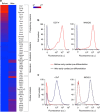Bioengineering of injectable encapsulated aggregates of pluripotent stem cells for therapy of myocardial infarction
- PMID: 27786170
- PMCID: PMC5095349
- DOI: 10.1038/ncomms13306
Bioengineering of injectable encapsulated aggregates of pluripotent stem cells for therapy of myocardial infarction
Abstract
It is difficult to achieve minimally invasive injectable cell delivery while maintaining high cell retention and animal survival for in vivo stem cell therapy of myocardial infarction. Here we show that pluripotent stem cell aggregates pre-differentiated into the early cardiac lineage and encapsulated in a biocompatible and biodegradable micromatrix, are suitable for injectable delivery. This method significantly improves the survival of the injected cells by more than six-fold compared with the conventional practice of injecting single cells, and effectively prevents teratoma formation. Moreover, this method significantly enhances cardiac function and survival of animals after myocardial infarction, as a result of a localized immunosuppression effect of the micromatrix and the in situ cardiac regeneration by the injected cells.
Conflict of interest statement
X.H. disclosed the idea reported in this work to the Technology and Commercialization Office at The Ohio State University. N.W. is a Co-Founder and Chief Scientific Officer at TRIM-edicine, Inc. and has no competing financial interests on this study. The remaining authors declare no competing financial interests.
Figures





Similar articles
-
Derivation of pluripotent stem cells from nascent undifferentiated teratoma.Dev Biol. 2019 Feb 1;446(1):43-55. doi: 10.1016/j.ydbio.2018.11.020. Epub 2018 Dec 5. Dev Biol. 2019. PMID: 30529251
-
Stem cell therapies for myocardial infarction in clinical trials: bioengineering and biomaterial aspects.Lab Invest. 2017 Oct;97(10):1167-1179. doi: 10.1038/labinvest.2017.100. Epub 2017 Sep 4. Lab Invest. 2017. PMID: 28869589 Review.
-
Rho-associated kinase inhibitors promote the cardiac differentiation of embryonic and induced pluripotent stem cells.Int J Cardiol. 2015 Dec 15;201:441-8. doi: 10.1016/j.ijcard.2015.08.118. Epub 2015 Aug 15. Int J Cardiol. 2015. PMID: 26313863
-
Stage specific transcriptome profiles at cardiac lineage commitment during cardiomyocyte differentiation from mouse and human pluripotent stem cells.BMB Rep. 2021 Sep;54(9):464-469. doi: 10.5483/BMBRep.2021.54.9.046. BMB Rep. 2021. PMID: 34120677 Free PMC article.
-
Induced pluripotent stem cells for post-myocardial infarction repair: remarkable opportunities and challenges.Circ Res. 2014 Apr 11;114(8):1328-45. doi: 10.1161/CIRCRESAHA.114.300556. Circ Res. 2014. PMID: 24723658 Free PMC article. Review.
Cited by
-
Minimally Invasive Delivery of 3D Shape Recoverable Constructs with Ordered Structures for Tissue Repair.ACS Biomater Sci Eng. 2021 Jun 14;7(6):2204-2211. doi: 10.1021/acsbiomaterials.1c00344. Epub 2021 Apr 30. ACS Biomater Sci Eng. 2021. PMID: 33929841 Free PMC article.
-
Synergistic Effect of Biomaterial and Stem Cell for Skin Tissue Engineering in Cutaneous Wound Healing: A Concise Review.Polymers (Basel). 2021 May 12;13(10):1546. doi: 10.3390/polym13101546. Polymers (Basel). 2021. PMID: 34065898 Free PMC article. Review.
-
Requirements for Proper Immunosuppressive Regimens to Limit Translational Failure of Cardiac Cell Therapy in Preclinical Large Animal Models.J Cardiovasc Transl Res. 2021 Feb;14(1):88-99. doi: 10.1007/s12265-020-10035-2. Epub 2020 May 31. J Cardiovasc Transl Res. 2021. PMID: 32476086 Free PMC article. Review.
-
A Simple and Fast Method for Derivation of blastocyst-like cell aggregates (BLCAs) from Murine Embryonic Stem Cells.J Biomater Tissue Eng. 2018 Jul;8(7):1004-1009. doi: 10.1166/jbt.2018.1832. J Biomater Tissue Eng. 2018. PMID: 30906649 Free PMC article.
-
Scalable Production and Cryostorage of Organoids Using Core-Shell Decoupled Hydrogel Capsules.Adv Biosyst. 2017 Dec;1(12):1700165. doi: 10.1002/adbi.201700165. Epub 2017 Nov 22. Adv Biosyst. 2017. PMID: 29607405 Free PMC article.
References
-
- Mozaffarian D. et al.. Heart disease and stroke statistics-2016 update: a report from the American Heart Association. Circulation 133, e38–e360 (2016). - PubMed
-
- Laslett L. J. et al.. The worldwide environment of cardiovascular disease: prevalence, diagnosis, therapy, and policy issues: a report from the American College of Cardiology. J. Am. Coll. Cardiol. 60, S1–49 (2012). - PubMed
-
- Segers V. F. & Lee R. T. Stem-cell therapy for cardiac disease. Nature 451, 937–942 (2008). - PubMed
Publication types
MeSH terms
Substances
Grants and funding
LinkOut - more resources
Full Text Sources
Other Literature Sources
Medical
Molecular Biology Databases

